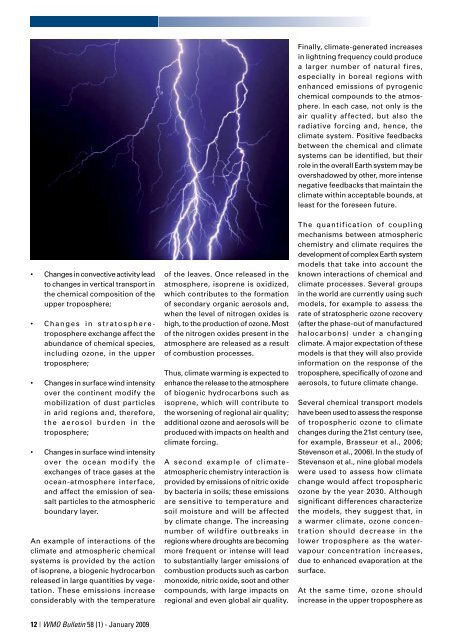Weather, climate and the air we breathe - WMO
Weather, climate and the air we breathe - WMO
Weather, climate and the air we breathe - WMO
Create successful ePaper yourself
Turn your PDF publications into a flip-book with our unique Google optimized e-Paper software.
•<br />
•<br />
•<br />
•<br />
Changes in convective activity lead<br />
to changes in vertical transport in<br />
<strong>the</strong> chemical composition of <strong>the</strong><br />
upper troposphere;<br />
Changes in stratospheretroposphere<br />
exchange affect <strong>the</strong><br />
abundance of chemical species,<br />
including ozone, in <strong>the</strong> upper<br />
troposphere;<br />
Changes in surface wind intensity<br />
over <strong>the</strong> continent modify <strong>the</strong><br />
mobilization of dust particles<br />
in arid regions <strong>and</strong>, <strong>the</strong>refore,<br />
<strong>the</strong> aerosol burden in <strong>the</strong><br />
troposphere;<br />
Changes in surface wind intensity<br />
over <strong>the</strong> ocean modify <strong>the</strong><br />
exchanges of trace gases at <strong>the</strong><br />
ocean-atmosphere interface,<br />
<strong>and</strong> affect <strong>the</strong> emission of seasalt<br />
particles to <strong>the</strong> atmospheric<br />
boundary layer.<br />
An example of interactions of <strong>the</strong><br />
<strong>climate</strong> <strong>and</strong> atmospheric chemical<br />
systems is provided by <strong>the</strong> action<br />
of isoprene, a biogenic hydrocarbon<br />
released in large quantities by vegetation.<br />
These emissions increase<br />
considerably with <strong>the</strong> temperature<br />
12 | <strong>WMO</strong> Bulletin 58 (1) - January 2009<br />
of <strong>the</strong> leaves. Once released in <strong>the</strong><br />
atmosphere, isoprene is oxidized,<br />
which contributes to <strong>the</strong> formation<br />
of secondary organic aerosols <strong>and</strong>,<br />
when <strong>the</strong> level of nitrogen oxides is<br />
high, to <strong>the</strong> production of ozone. Most<br />
of <strong>the</strong> nitrogen oxides present in <strong>the</strong><br />
atmosphere are released as a result<br />
of combustion processes.<br />
Thus, <strong>climate</strong> warming is expected to<br />
enhance <strong>the</strong> release to <strong>the</strong> atmosphere<br />
of biogenic hydrocarbons such as<br />
isoprene, which will contribute to<br />
<strong>the</strong> worsening of regional <strong>air</strong> quality;<br />
additional ozone <strong>and</strong> aerosols will be<br />
produced with impacts on health <strong>and</strong><br />
<strong>climate</strong> forcing.<br />
A second example of <strong>climate</strong>atmospheric<br />
chemistry interaction is<br />
provided by emissions of nitric oxide<br />
by bacteria in soils; <strong>the</strong>se emissions<br />
are sensitive to temperature <strong>and</strong><br />
soil moisture <strong>and</strong> will be affected<br />
by <strong>climate</strong> change. The increasing<br />
number of wildfire outbreaks in<br />
regions where droughts are becoming<br />
more frequent or intense will lead<br />
to substantially larger emissions of<br />
combustion products such as carbon<br />
monoxide, nitric oxide, soot <strong>and</strong> o<strong>the</strong>r<br />
compounds, with large impacts on<br />
regional <strong>and</strong> even global <strong>air</strong> quality.<br />
Finally, <strong>climate</strong>-generated increases<br />
in lightning frequency could produce<br />
a larger number of natural fires,<br />
especially in boreal regions with<br />
enhanced emissions of pyrogenic<br />
chemical compounds to <strong>the</strong> atmosphere.<br />
In each case, not only is <strong>the</strong><br />
<strong>air</strong> quality affected, but also <strong>the</strong><br />
radiative forcing <strong>and</strong>, hence, <strong>the</strong><br />
<strong>climate</strong> system. Positive feedbacks<br />
bet<strong>we</strong>en <strong>the</strong> chemical <strong>and</strong> <strong>climate</strong><br />
systems can be identified, but <strong>the</strong>ir<br />
role in <strong>the</strong> overall Earth system may be<br />
overshado<strong>we</strong>d by o<strong>the</strong>r, more intense<br />
negative feedbacks that maintain <strong>the</strong><br />
<strong>climate</strong> within acceptable bounds, at<br />
least for <strong>the</strong> foreseen future.<br />
The quantification of coupling<br />
mechanisms bet<strong>we</strong>en atmospheric<br />
chemistry <strong>and</strong> <strong>climate</strong> requires <strong>the</strong><br />
development of complex Earth system<br />
models that take into account <strong>the</strong><br />
known interactions of chemical <strong>and</strong><br />
<strong>climate</strong> processes. Several groups<br />
in <strong>the</strong> world are currently using such<br />
models, for example to assess <strong>the</strong><br />
rate of stratospheric ozone recovery<br />
(after <strong>the</strong> phase-out of manufactured<br />
halocarbons) under a changing<br />
<strong>climate</strong>. A major expectation of <strong>the</strong>se<br />
models is that <strong>the</strong>y will also provide<br />
information on <strong>the</strong> response of <strong>the</strong><br />
troposphere, specifically of ozone <strong>and</strong><br />
aerosols, to future <strong>climate</strong> change.<br />
Several chemical transport models<br />
have been used to assess <strong>the</strong> response<br />
of tropospheric ozone to <strong>climate</strong><br />
changes during <strong>the</strong> 21st century (see,<br />
for example, Brasseur et al., 2006;<br />
Stevenson et al., 2006). In <strong>the</strong> study of<br />
Stevenson et al., nine global models<br />
<strong>we</strong>re used to assess how <strong>climate</strong><br />
change would affect tropospheric<br />
ozone by <strong>the</strong> year 2030. Although<br />
significant differences characterize<br />
<strong>the</strong> models, <strong>the</strong>y suggest that, in<br />
a warmer <strong>climate</strong>, ozone concentration<br />
should decrease in <strong>the</strong><br />
lo<strong>we</strong>r troposphere as <strong>the</strong> watervapour<br />
concentration increases,<br />
due to enhanced evaporation at <strong>the</strong><br />
surface.<br />
At <strong>the</strong> same time, ozone should<br />
increase in <strong>the</strong> upper troposphere as

















